Analysis of Mental Health Reforms in Australia: A Comprehensive Report
VerifiedAdded on 2020/05/04
|14
|3084
|37
Report
AI Summary
This report provides a detailed analysis of the mental health reforms implemented in Australia. It examines the strategies, plans, and policies adopted by the Australian government to improve mental health services, including the introduction of digitized health agencies and various funding packages. The report discusses the scopes for improvement within the existing system, highlighting the fragmented nature of the healthcare system and challenges related to patient care, regulatory compliance, and administrative tasks. Furthermore, it identifies the major challenges faced by managers of mental health organizations, such as collaboration with external resources, keeping up with regulations, and addressing cultural issues. The report concludes by summarizing the key changes and opportunities for improvement within the Australian mental health sector, emphasizing the importance of digitization and a more coordinated approach to healthcare delivery.

Running head: HEALTHCARE REFORMS AUSTRALIA
HEALTHCARE REFORMS AUSTRALIA
Name of the Student:
Name of the University:
Author Note:
HEALTHCARE REFORMS AUSTRALIA
Name of the Student:
Name of the University:
Author Note:
Paraphrase This Document
Need a fresh take? Get an instant paraphrase of this document with our AI Paraphraser
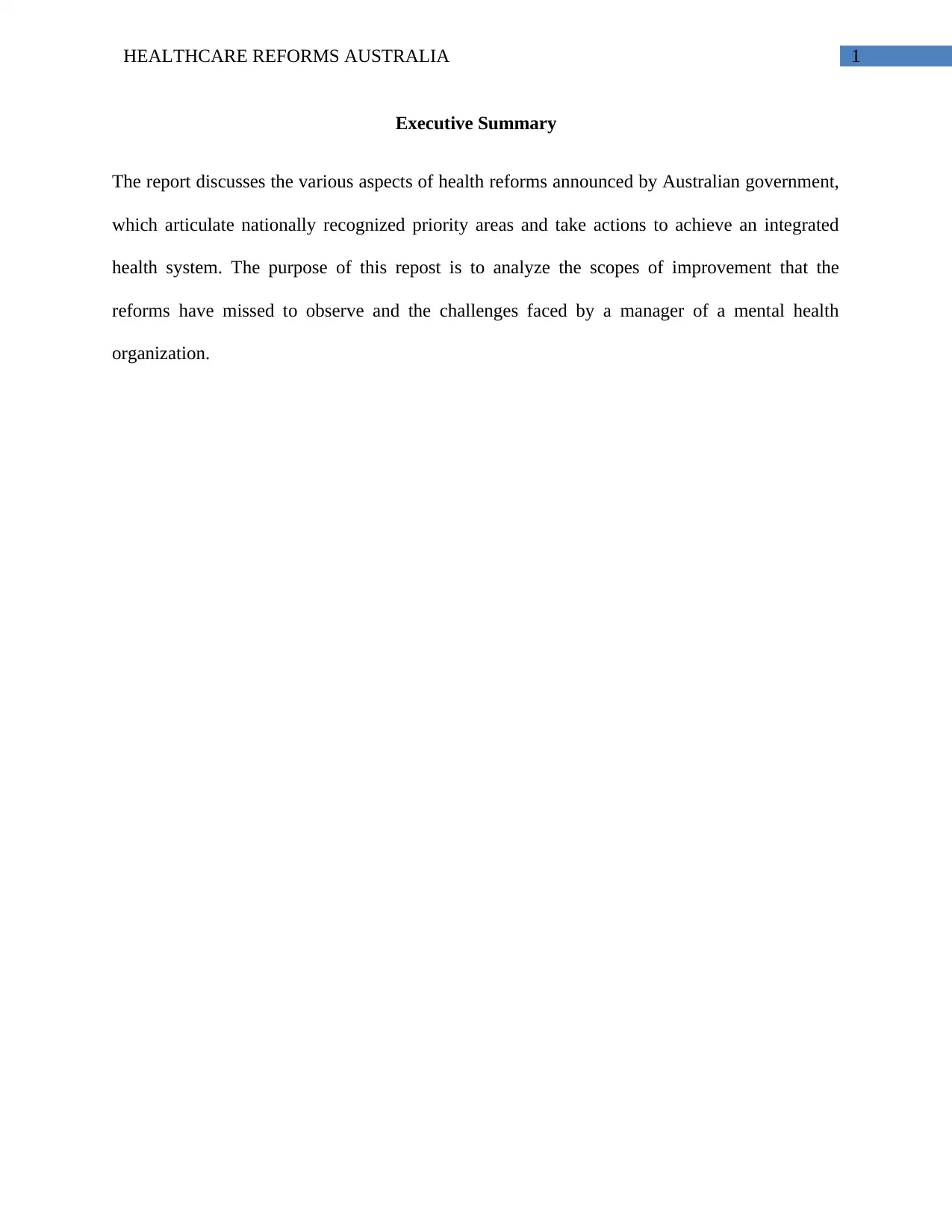
1HEALTHCARE REFORMS AUSTRALIA
Executive Summary
The report discusses the various aspects of health reforms announced by Australian government,
which articulate nationally recognized priority areas and take actions to achieve an integrated
health system. The purpose of this repost is to analyze the scopes of improvement that the
reforms have missed to observe and the challenges faced by a manager of a mental health
organization.
Executive Summary
The report discusses the various aspects of health reforms announced by Australian government,
which articulate nationally recognized priority areas and take actions to achieve an integrated
health system. The purpose of this repost is to analyze the scopes of improvement that the
reforms have missed to observe and the challenges faced by a manager of a mental health
organization.
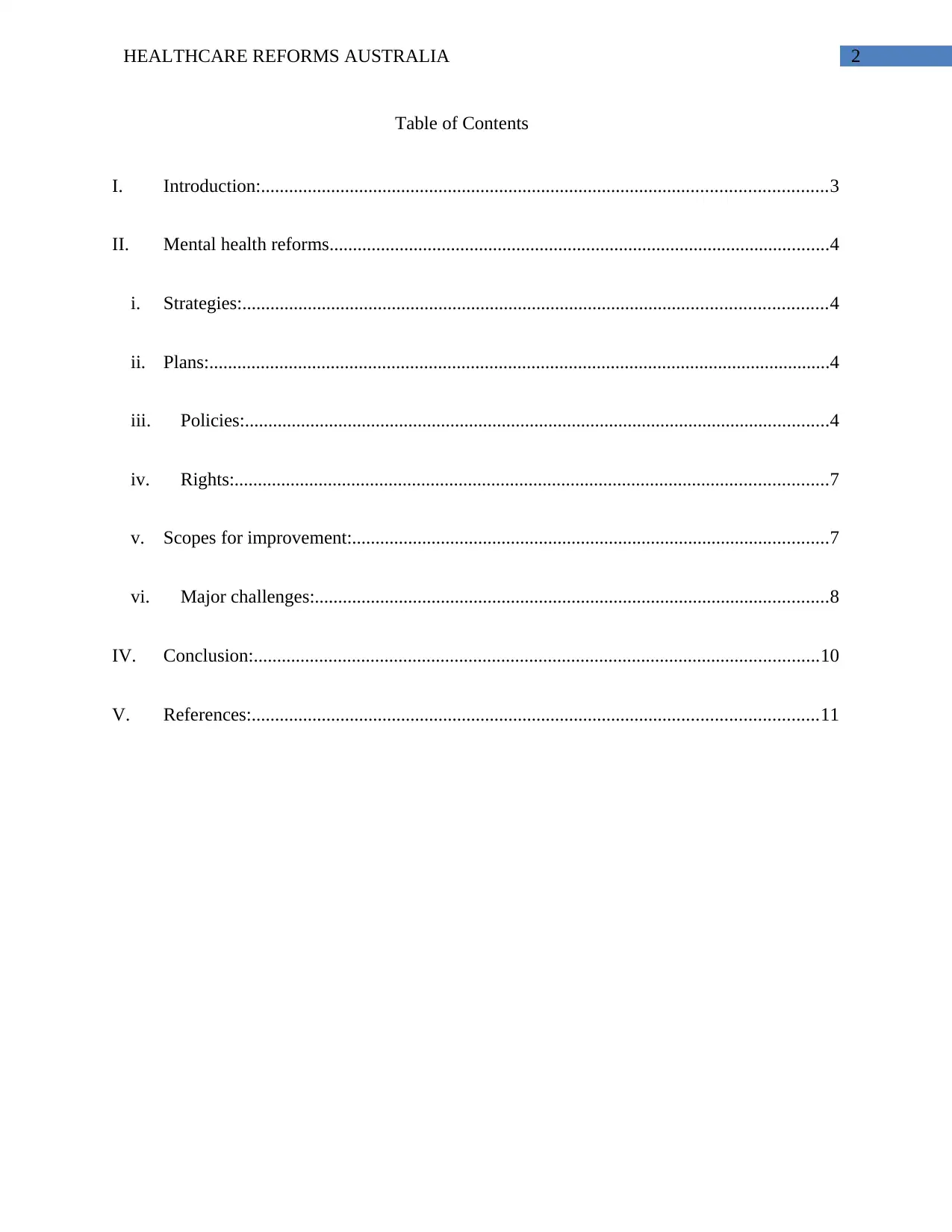
2HEALTHCARE REFORMS AUSTRALIA
Table of Contents
I. Introduction:.........................................................................................................................3
II. Mental health reforms...........................................................................................................4
i. Strategies:.............................................................................................................................4
ii. Plans:.....................................................................................................................................4
iii. Policies:.............................................................................................................................4
iv. Rights:...............................................................................................................................7
v. Scopes for improvement:......................................................................................................7
vi. Major challenges:..............................................................................................................8
IV. Conclusion:.........................................................................................................................10
V. References:.........................................................................................................................11
Table of Contents
I. Introduction:.........................................................................................................................3
II. Mental health reforms...........................................................................................................4
i. Strategies:.............................................................................................................................4
ii. Plans:.....................................................................................................................................4
iii. Policies:.............................................................................................................................4
iv. Rights:...............................................................................................................................7
v. Scopes for improvement:......................................................................................................7
vi. Major challenges:..............................................................................................................8
IV. Conclusion:.........................................................................................................................10
V. References:.........................................................................................................................11
⊘ This is a preview!⊘
Do you want full access?
Subscribe today to unlock all pages.

Trusted by 1+ million students worldwide
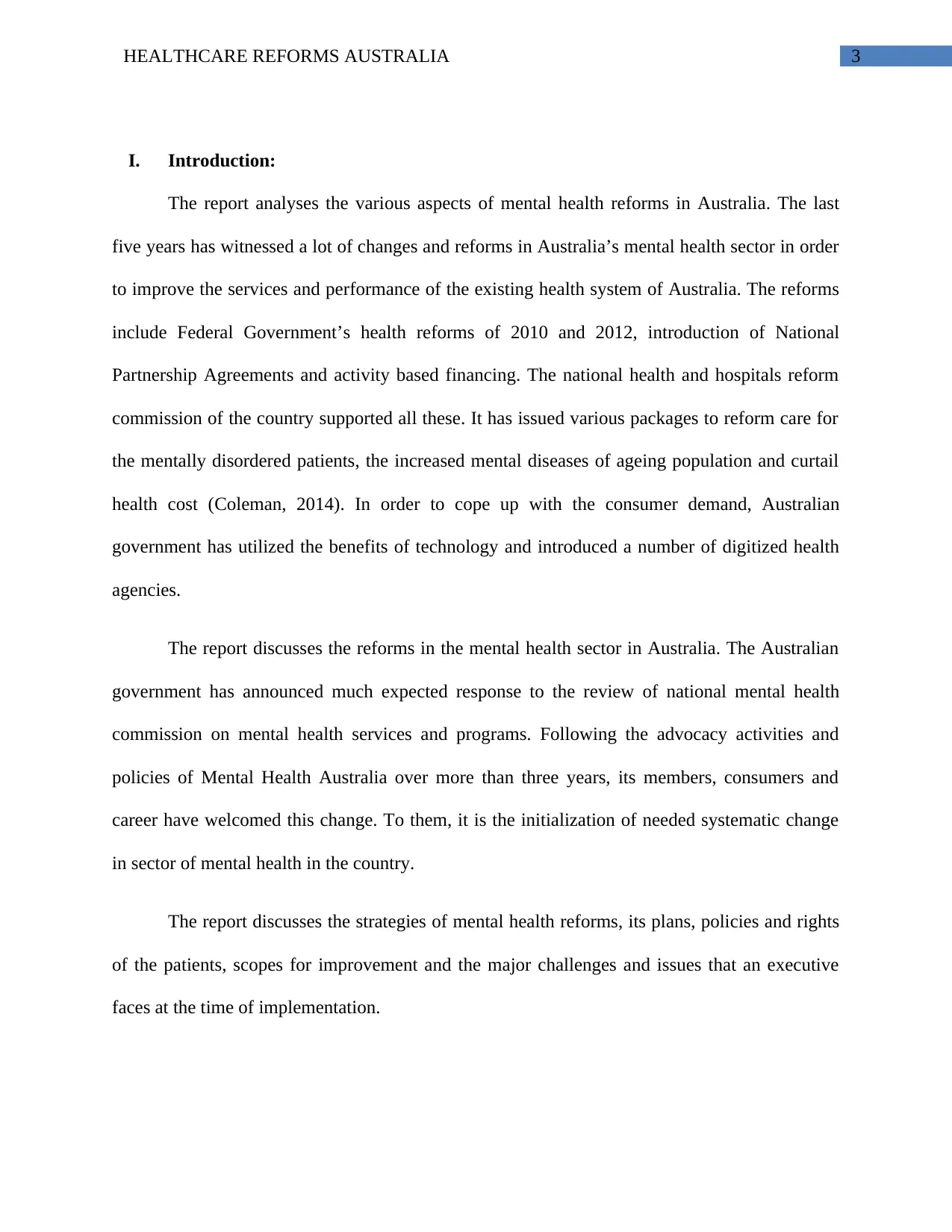
3HEALTHCARE REFORMS AUSTRALIA
I. Introduction:
The report analyses the various aspects of mental health reforms in Australia. The last
five years has witnessed a lot of changes and reforms in Australia’s mental health sector in order
to improve the services and performance of the existing health system of Australia. The reforms
include Federal Government’s health reforms of 2010 and 2012, introduction of National
Partnership Agreements and activity based financing. The national health and hospitals reform
commission of the country supported all these. It has issued various packages to reform care for
the mentally disordered patients, the increased mental diseases of ageing population and curtail
health cost (Coleman, 2014). In order to cope up with the consumer demand, Australian
government has utilized the benefits of technology and introduced a number of digitized health
agencies.
The report discusses the reforms in the mental health sector in Australia. The Australian
government has announced much expected response to the review of national mental health
commission on mental health services and programs. Following the advocacy activities and
policies of Mental Health Australia over more than three years, its members, consumers and
career have welcomed this change. To them, it is the initialization of needed systematic change
in sector of mental health in the country.
The report discusses the strategies of mental health reforms, its plans, policies and rights
of the patients, scopes for improvement and the major challenges and issues that an executive
faces at the time of implementation.
I. Introduction:
The report analyses the various aspects of mental health reforms in Australia. The last
five years has witnessed a lot of changes and reforms in Australia’s mental health sector in order
to improve the services and performance of the existing health system of Australia. The reforms
include Federal Government’s health reforms of 2010 and 2012, introduction of National
Partnership Agreements and activity based financing. The national health and hospitals reform
commission of the country supported all these. It has issued various packages to reform care for
the mentally disordered patients, the increased mental diseases of ageing population and curtail
health cost (Coleman, 2014). In order to cope up with the consumer demand, Australian
government has utilized the benefits of technology and introduced a number of digitized health
agencies.
The report discusses the reforms in the mental health sector in Australia. The Australian
government has announced much expected response to the review of national mental health
commission on mental health services and programs. Following the advocacy activities and
policies of Mental Health Australia over more than three years, its members, consumers and
career have welcomed this change. To them, it is the initialization of needed systematic change
in sector of mental health in the country.
The report discusses the strategies of mental health reforms, its plans, policies and rights
of the patients, scopes for improvement and the major challenges and issues that an executive
faces at the time of implementation.
Paraphrase This Document
Need a fresh take? Get an instant paraphrase of this document with our AI Paraphraser
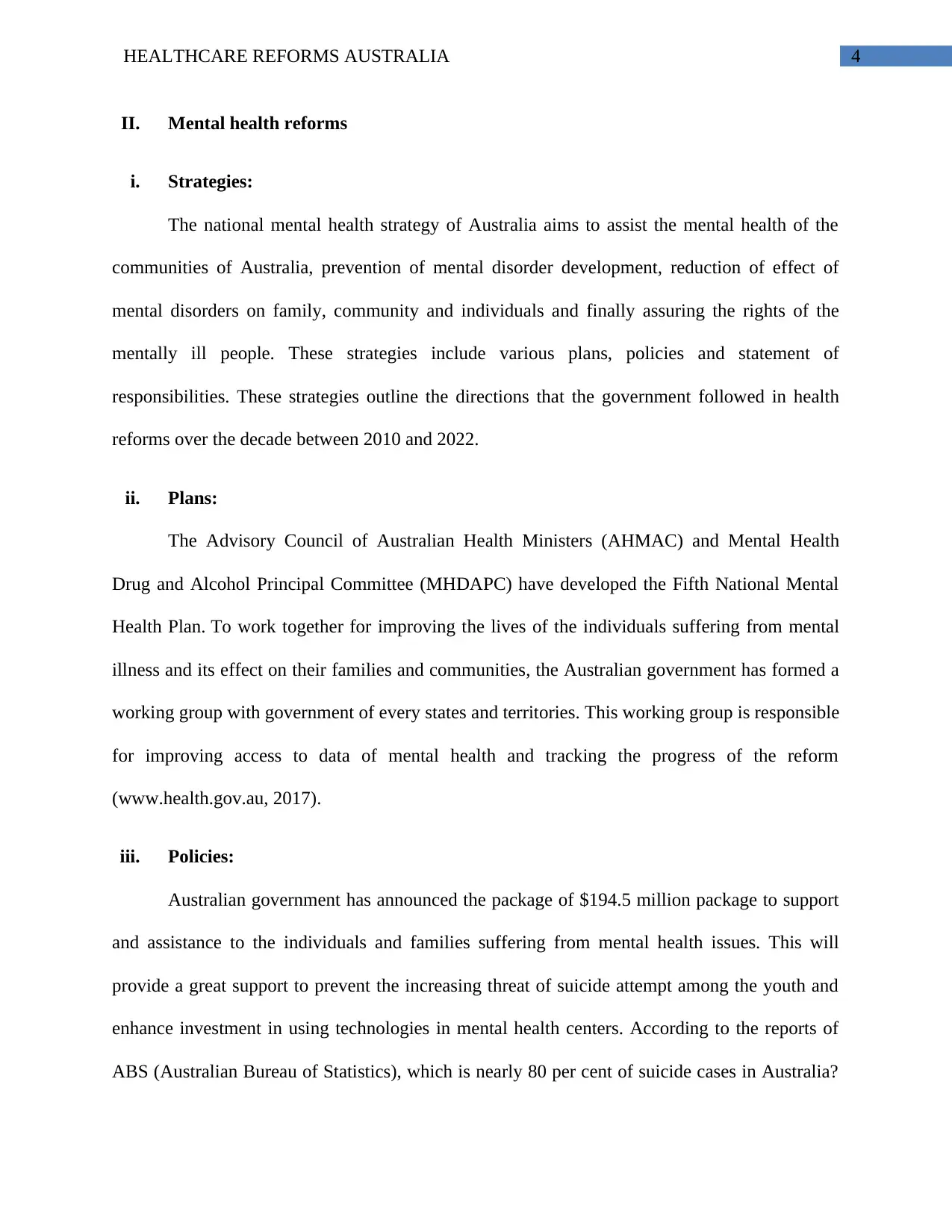
4HEALTHCARE REFORMS AUSTRALIA
II. Mental health reforms
i. Strategies:
The national mental health strategy of Australia aims to assist the mental health of the
communities of Australia, prevention of mental disorder development, reduction of effect of
mental disorders on family, community and individuals and finally assuring the rights of the
mentally ill people. These strategies include various plans, policies and statement of
responsibilities. These strategies outline the directions that the government followed in health
reforms over the decade between 2010 and 2022.
ii. Plans:
The Advisory Council of Australian Health Ministers (AHMAC) and Mental Health
Drug and Alcohol Principal Committee (MHDAPC) have developed the Fifth National Mental
Health Plan. To work together for improving the lives of the individuals suffering from mental
illness and its effect on their families and communities, the Australian government has formed a
working group with government of every states and territories. This working group is responsible
for improving access to data of mental health and tracking the progress of the reform
(www.health.gov.au, 2017).
iii. Policies:
Australian government has announced the package of $194.5 million package to support
and assistance to the individuals and families suffering from mental health issues. This will
provide a great support to prevent the increasing threat of suicide attempt among the youth and
enhance investment in using technologies in mental health centers. According to the reports of
ABS (Australian Bureau of Statistics), which is nearly 80 per cent of suicide cases in Australia?
II. Mental health reforms
i. Strategies:
The national mental health strategy of Australia aims to assist the mental health of the
communities of Australia, prevention of mental disorder development, reduction of effect of
mental disorders on family, community and individuals and finally assuring the rights of the
mentally ill people. These strategies include various plans, policies and statement of
responsibilities. These strategies outline the directions that the government followed in health
reforms over the decade between 2010 and 2022.
ii. Plans:
The Advisory Council of Australian Health Ministers (AHMAC) and Mental Health
Drug and Alcohol Principal Committee (MHDAPC) have developed the Fifth National Mental
Health Plan. To work together for improving the lives of the individuals suffering from mental
illness and its effect on their families and communities, the Australian government has formed a
working group with government of every states and territories. This working group is responsible
for improving access to data of mental health and tracking the progress of the reform
(www.health.gov.au, 2017).
iii. Policies:
Australian government has announced the package of $194.5 million package to support
and assistance to the individuals and families suffering from mental health issues. This will
provide a great support to prevent the increasing threat of suicide attempt among the youth and
enhance investment in using technologies in mental health centers. According to the reports of
ABS (Australian Bureau of Statistics), which is nearly 80 per cent of suicide cases in Australia?
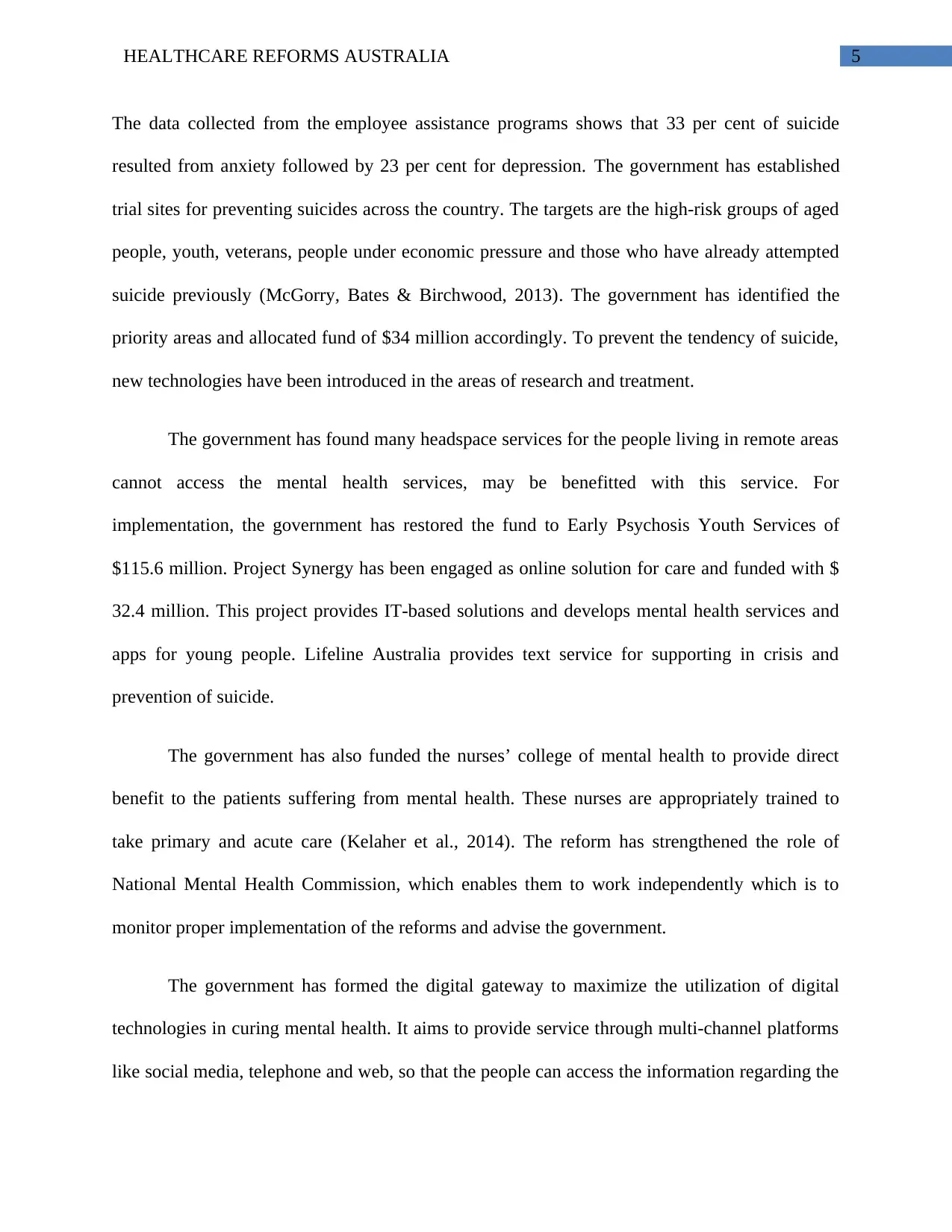
5HEALTHCARE REFORMS AUSTRALIA
The data collected from the employee assistance programs shows that 33 per cent of suicide
resulted from anxiety followed by 23 per cent for depression. The government has established
trial sites for preventing suicides across the country. The targets are the high-risk groups of aged
people, youth, veterans, people under economic pressure and those who have already attempted
suicide previously (McGorry, Bates & Birchwood, 2013). The government has identified the
priority areas and allocated fund of $34 million accordingly. To prevent the tendency of suicide,
new technologies have been introduced in the areas of research and treatment.
The government has found many headspace services for the people living in remote areas
cannot access the mental health services, may be benefitted with this service. For
implementation, the government has restored the fund to Early Psychosis Youth Services of
$115.6 million. Project Synergy has been engaged as online solution for care and funded with $
32.4 million. This project provides IT-based solutions and develops mental health services and
apps for young people. Lifeline Australia provides text service for supporting in crisis and
prevention of suicide.
The government has also funded the nurses’ college of mental health to provide direct
benefit to the patients suffering from mental health. These nurses are appropriately trained to
take primary and acute care (Kelaher et al., 2014). The reform has strengthened the role of
National Mental Health Commission, which enables them to work independently which is to
monitor proper implementation of the reforms and advise the government.
The government has formed the digital gateway to maximize the utilization of digital
technologies in curing mental health. It aims to provide service through multi-channel platforms
like social media, telephone and web, so that the people can access the information regarding the
The data collected from the employee assistance programs shows that 33 per cent of suicide
resulted from anxiety followed by 23 per cent for depression. The government has established
trial sites for preventing suicides across the country. The targets are the high-risk groups of aged
people, youth, veterans, people under economic pressure and those who have already attempted
suicide previously (McGorry, Bates & Birchwood, 2013). The government has identified the
priority areas and allocated fund of $34 million accordingly. To prevent the tendency of suicide,
new technologies have been introduced in the areas of research and treatment.
The government has found many headspace services for the people living in remote areas
cannot access the mental health services, may be benefitted with this service. For
implementation, the government has restored the fund to Early Psychosis Youth Services of
$115.6 million. Project Synergy has been engaged as online solution for care and funded with $
32.4 million. This project provides IT-based solutions and develops mental health services and
apps for young people. Lifeline Australia provides text service for supporting in crisis and
prevention of suicide.
The government has also funded the nurses’ college of mental health to provide direct
benefit to the patients suffering from mental health. These nurses are appropriately trained to
take primary and acute care (Kelaher et al., 2014). The reform has strengthened the role of
National Mental Health Commission, which enables them to work independently which is to
monitor proper implementation of the reforms and advise the government.
The government has formed the digital gateway to maximize the utilization of digital
technologies in curing mental health. It aims to provide service through multi-channel platforms
like social media, telephone and web, so that the people can access the information regarding the
⊘ This is a preview!⊘
Do you want full access?
Subscribe today to unlock all pages.

Trusted by 1+ million students worldwide
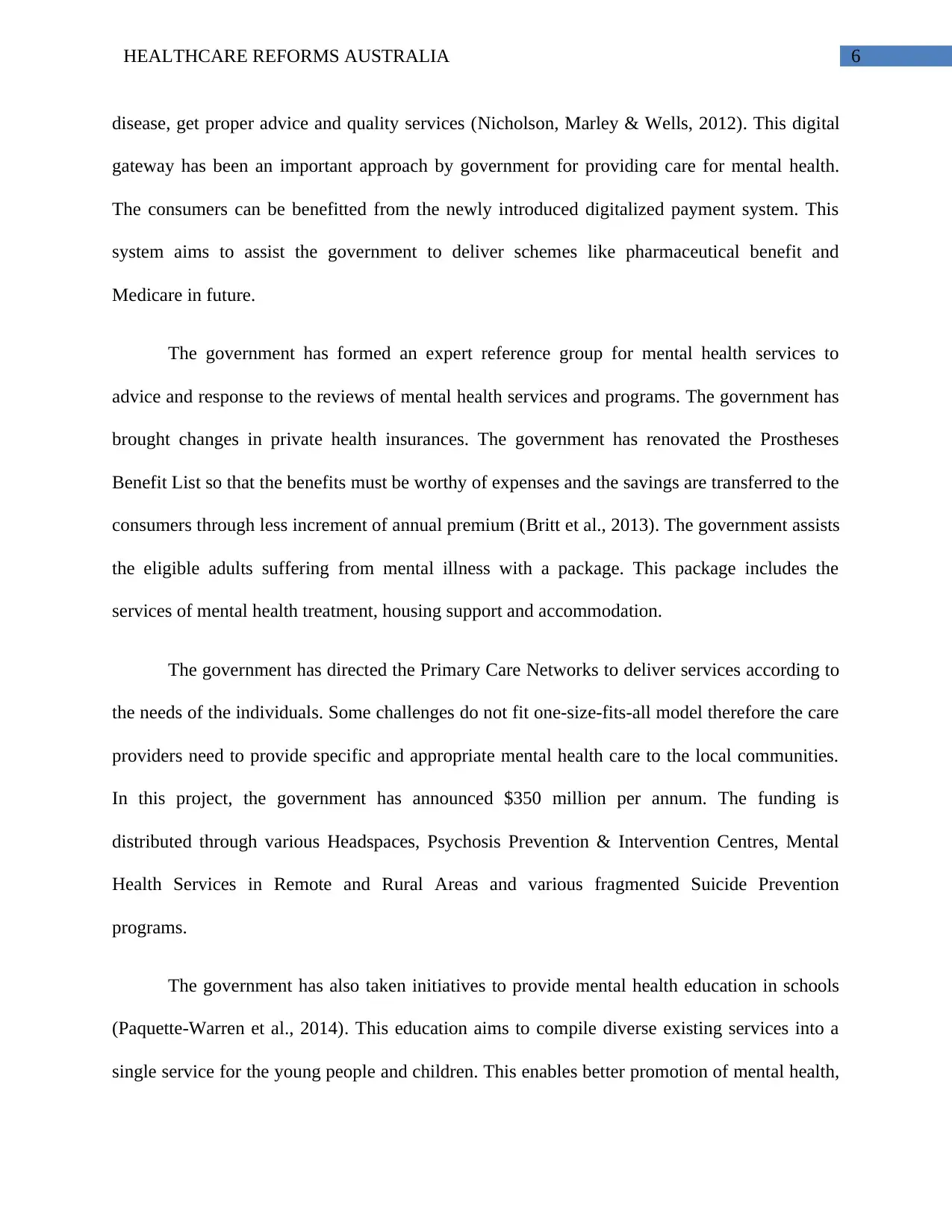
6HEALTHCARE REFORMS AUSTRALIA
disease, get proper advice and quality services (Nicholson, Marley & Wells, 2012). This digital
gateway has been an important approach by government for providing care for mental health.
The consumers can be benefitted from the newly introduced digitalized payment system. This
system aims to assist the government to deliver schemes like pharmaceutical benefit and
Medicare in future.
The government has formed an expert reference group for mental health services to
advice and response to the reviews of mental health services and programs. The government has
brought changes in private health insurances. The government has renovated the Prostheses
Benefit List so that the benefits must be worthy of expenses and the savings are transferred to the
consumers through less increment of annual premium (Britt et al., 2013). The government assists
the eligible adults suffering from mental illness with a package. This package includes the
services of mental health treatment, housing support and accommodation.
The government has directed the Primary Care Networks to deliver services according to
the needs of the individuals. Some challenges do not fit one-size-fits-all model therefore the care
providers need to provide specific and appropriate mental health care to the local communities.
In this project, the government has announced $350 million per annum. The funding is
distributed through various Headspaces, Psychosis Prevention & Intervention Centres, Mental
Health Services in Remote and Rural Areas and various fragmented Suicide Prevention
programs.
The government has also taken initiatives to provide mental health education in schools
(Paquette-Warren et al., 2014). This education aims to compile diverse existing services into a
single service for the young people and children. This enables better promotion of mental health,
disease, get proper advice and quality services (Nicholson, Marley & Wells, 2012). This digital
gateway has been an important approach by government for providing care for mental health.
The consumers can be benefitted from the newly introduced digitalized payment system. This
system aims to assist the government to deliver schemes like pharmaceutical benefit and
Medicare in future.
The government has formed an expert reference group for mental health services to
advice and response to the reviews of mental health services and programs. The government has
brought changes in private health insurances. The government has renovated the Prostheses
Benefit List so that the benefits must be worthy of expenses and the savings are transferred to the
consumers through less increment of annual premium (Britt et al., 2013). The government assists
the eligible adults suffering from mental illness with a package. This package includes the
services of mental health treatment, housing support and accommodation.
The government has directed the Primary Care Networks to deliver services according to
the needs of the individuals. Some challenges do not fit one-size-fits-all model therefore the care
providers need to provide specific and appropriate mental health care to the local communities.
In this project, the government has announced $350 million per annum. The funding is
distributed through various Headspaces, Psychosis Prevention & Intervention Centres, Mental
Health Services in Remote and Rural Areas and various fragmented Suicide Prevention
programs.
The government has also taken initiatives to provide mental health education in schools
(Paquette-Warren et al., 2014). This education aims to compile diverse existing services into a
single service for the young people and children. This enables better promotion of mental health,
Paraphrase This Document
Need a fresh take? Get an instant paraphrase of this document with our AI Paraphraser
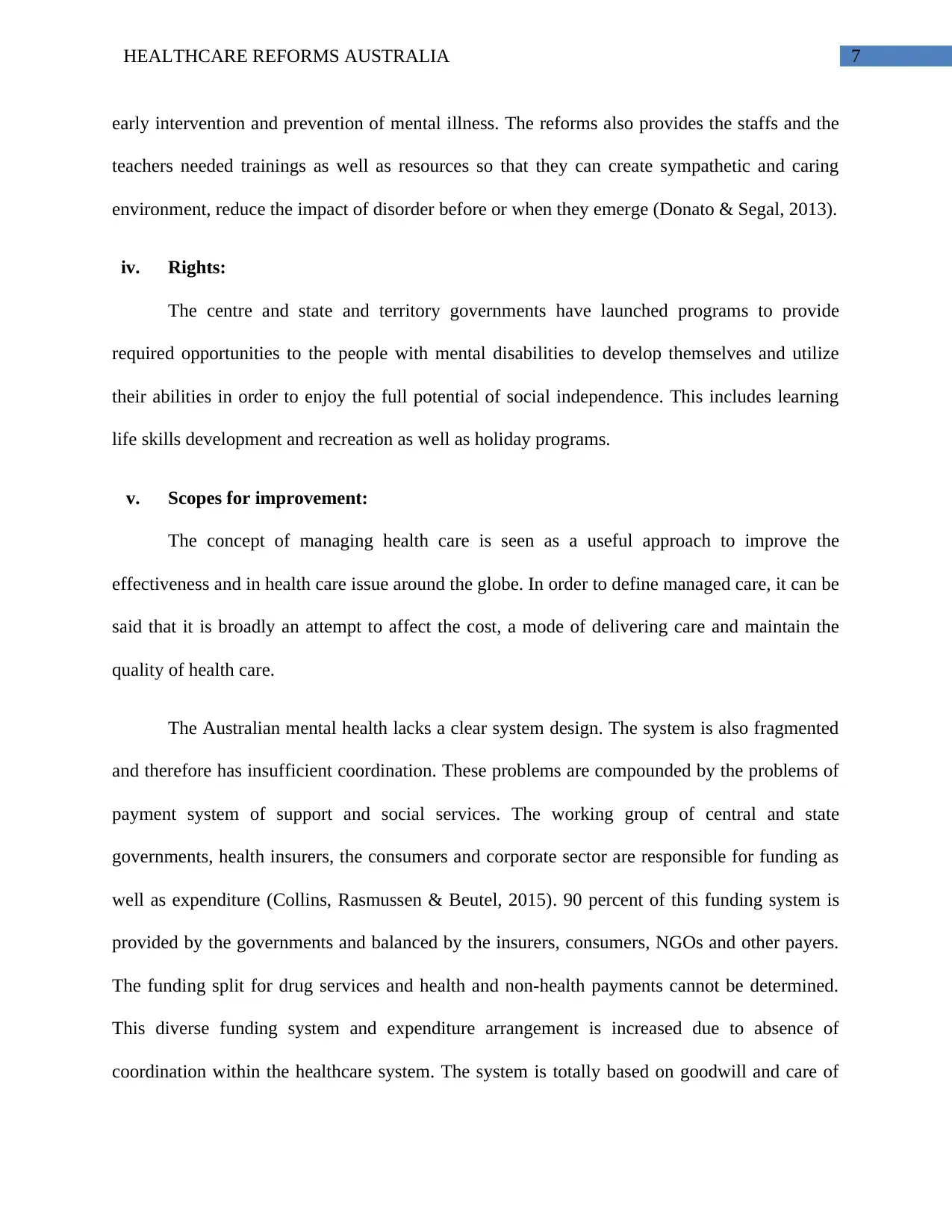
7HEALTHCARE REFORMS AUSTRALIA
early intervention and prevention of mental illness. The reforms also provides the staffs and the
teachers needed trainings as well as resources so that they can create sympathetic and caring
environment, reduce the impact of disorder before or when they emerge (Donato & Segal, 2013).
iv. Rights:
The centre and state and territory governments have launched programs to provide
required opportunities to the people with mental disabilities to develop themselves and utilize
their abilities in order to enjoy the full potential of social independence. This includes learning
life skills development and recreation as well as holiday programs.
v. Scopes for improvement:
The concept of managing health care is seen as a useful approach to improve the
effectiveness and in health care issue around the globe. In order to define managed care, it can be
said that it is broadly an attempt to affect the cost, a mode of delivering care and maintain the
quality of health care.
The Australian mental health lacks a clear system design. The system is also fragmented
and therefore has insufficient coordination. These problems are compounded by the problems of
payment system of support and social services. The working group of central and state
governments, health insurers, the consumers and corporate sector are responsible for funding as
well as expenditure (Collins, Rasmussen & Beutel, 2015). 90 percent of this funding system is
provided by the governments and balanced by the insurers, consumers, NGOs and other payers.
The funding split for drug services and health and non-health payments cannot be determined.
This diverse funding system and expenditure arrangement is increased due to absence of
coordination within the healthcare system. The system is totally based on goodwill and care of
early intervention and prevention of mental illness. The reforms also provides the staffs and the
teachers needed trainings as well as resources so that they can create sympathetic and caring
environment, reduce the impact of disorder before or when they emerge (Donato & Segal, 2013).
iv. Rights:
The centre and state and territory governments have launched programs to provide
required opportunities to the people with mental disabilities to develop themselves and utilize
their abilities in order to enjoy the full potential of social independence. This includes learning
life skills development and recreation as well as holiday programs.
v. Scopes for improvement:
The concept of managing health care is seen as a useful approach to improve the
effectiveness and in health care issue around the globe. In order to define managed care, it can be
said that it is broadly an attempt to affect the cost, a mode of delivering care and maintain the
quality of health care.
The Australian mental health lacks a clear system design. The system is also fragmented
and therefore has insufficient coordination. These problems are compounded by the problems of
payment system of support and social services. The working group of central and state
governments, health insurers, the consumers and corporate sector are responsible for funding as
well as expenditure (Collins, Rasmussen & Beutel, 2015). 90 percent of this funding system is
provided by the governments and balanced by the insurers, consumers, NGOs and other payers.
The funding split for drug services and health and non-health payments cannot be determined.
This diverse funding system and expenditure arrangement is increased due to absence of
coordination within the healthcare system. The system is totally based on goodwill and care of
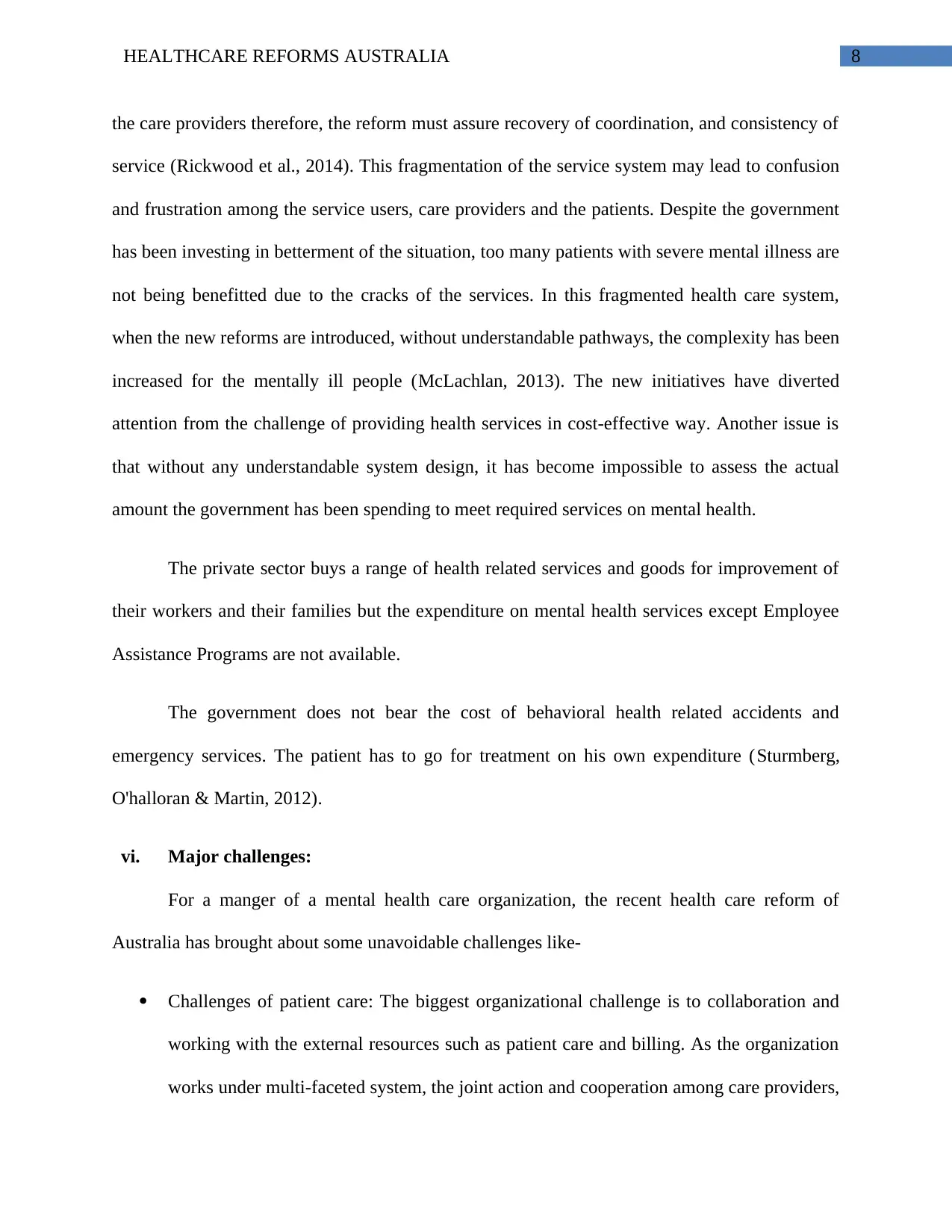
8HEALTHCARE REFORMS AUSTRALIA
the care providers therefore, the reform must assure recovery of coordination, and consistency of
service (Rickwood et al., 2014). This fragmentation of the service system may lead to confusion
and frustration among the service users, care providers and the patients. Despite the government
has been investing in betterment of the situation, too many patients with severe mental illness are
not being benefitted due to the cracks of the services. In this fragmented health care system,
when the new reforms are introduced, without understandable pathways, the complexity has been
increased for the mentally ill people (McLachlan, 2013). The new initiatives have diverted
attention from the challenge of providing health services in cost-effective way. Another issue is
that without any understandable system design, it has become impossible to assess the actual
amount the government has been spending to meet required services on mental health.
The private sector buys a range of health related services and goods for improvement of
their workers and their families but the expenditure on mental health services except Employee
Assistance Programs are not available.
The government does not bear the cost of behavioral health related accidents and
emergency services. The patient has to go for treatment on his own expenditure (Sturmberg,
O'halloran & Martin, 2012).
vi. Major challenges:
For a manger of a mental health care organization, the recent health care reform of
Australia has brought about some unavoidable challenges like-
Challenges of patient care: The biggest organizational challenge is to collaboration and
working with the external resources such as patient care and billing. As the organization
works under multi-faceted system, the joint action and cooperation among care providers,
the care providers therefore, the reform must assure recovery of coordination, and consistency of
service (Rickwood et al., 2014). This fragmentation of the service system may lead to confusion
and frustration among the service users, care providers and the patients. Despite the government
has been investing in betterment of the situation, too many patients with severe mental illness are
not being benefitted due to the cracks of the services. In this fragmented health care system,
when the new reforms are introduced, without understandable pathways, the complexity has been
increased for the mentally ill people (McLachlan, 2013). The new initiatives have diverted
attention from the challenge of providing health services in cost-effective way. Another issue is
that without any understandable system design, it has become impossible to assess the actual
amount the government has been spending to meet required services on mental health.
The private sector buys a range of health related services and goods for improvement of
their workers and their families but the expenditure on mental health services except Employee
Assistance Programs are not available.
The government does not bear the cost of behavioral health related accidents and
emergency services. The patient has to go for treatment on his own expenditure (Sturmberg,
O'halloran & Martin, 2012).
vi. Major challenges:
For a manger of a mental health care organization, the recent health care reform of
Australia has brought about some unavoidable challenges like-
Challenges of patient care: The biggest organizational challenge is to collaboration and
working with the external resources such as patient care and billing. As the organization
works under multi-faceted system, the joint action and cooperation among care providers,
⊘ This is a preview!⊘
Do you want full access?
Subscribe today to unlock all pages.

Trusted by 1+ million students worldwide

9HEALTHCARE REFORMS AUSTRALIA
billing services, insurance companies and clearinghouses has become painful experiences
(Best et al., 2012).
Challenges to keep up with the regulations: One of the hardest organizational challenges
is to keep up with the regulation that the reform provides announced by the government
of Australia (Mason, 2013). The behavioral and mental health care sector always been
under pressure. The reason behind this is that both the federal and state governments have
subjected it of regular intervention. This compels the organization to change its workflow
to stay acquiescent.
Administrative tasks: the recent reforms have increased difficulties in performing the
administrative tasks and decision-making procedures. The functional duties of an
executive include patient registration, filing claims and documentation. The scenario has
now changed where these task have been performed by the care providers.
The reform does not take care of the cultural related challenges that the organization
faces. Cultural related frustrations vary from working with difficult people present both
inner and outer structure of the organization (Bateman, Henderson & Kezelman, 2013).
Interpersonal conflicts creates problem in workplaces, which need to be governed.
The government has also need to give more stress on creating awareness about the mental
health, which is almost a common issue in all over the world. Public indifference in
mental health care and importance of qualitative care has become challenge for a manger
(Hall, 2015).
billing services, insurance companies and clearinghouses has become painful experiences
(Best et al., 2012).
Challenges to keep up with the regulations: One of the hardest organizational challenges
is to keep up with the regulation that the reform provides announced by the government
of Australia (Mason, 2013). The behavioral and mental health care sector always been
under pressure. The reason behind this is that both the federal and state governments have
subjected it of regular intervention. This compels the organization to change its workflow
to stay acquiescent.
Administrative tasks: the recent reforms have increased difficulties in performing the
administrative tasks and decision-making procedures. The functional duties of an
executive include patient registration, filing claims and documentation. The scenario has
now changed where these task have been performed by the care providers.
The reform does not take care of the cultural related challenges that the organization
faces. Cultural related frustrations vary from working with difficult people present both
inner and outer structure of the organization (Bateman, Henderson & Kezelman, 2013).
Interpersonal conflicts creates problem in workplaces, which need to be governed.
The government has also need to give more stress on creating awareness about the mental
health, which is almost a common issue in all over the world. Public indifference in
mental health care and importance of qualitative care has become challenge for a manger
(Hall, 2015).
Paraphrase This Document
Need a fresh take? Get an instant paraphrase of this document with our AI Paraphraser
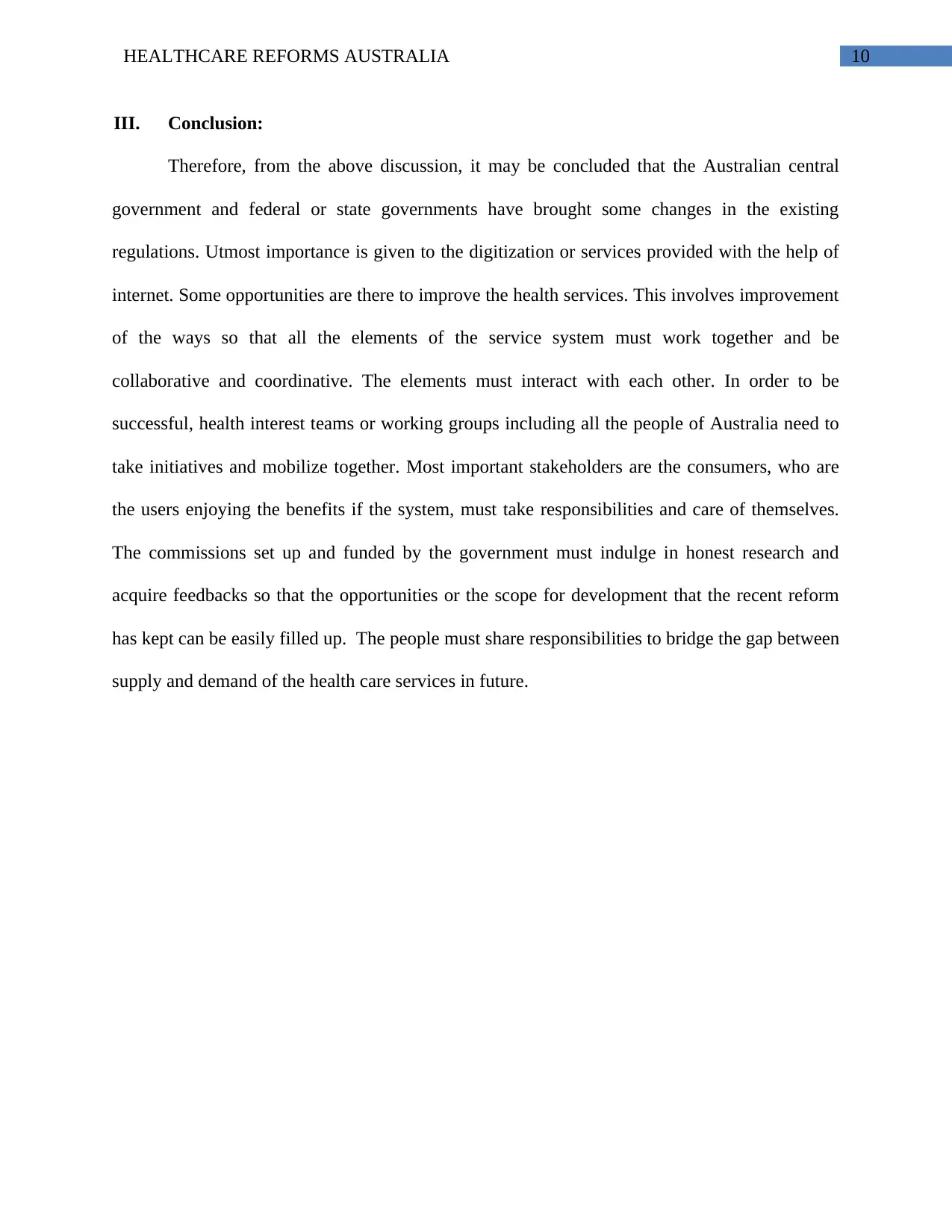
10HEALTHCARE REFORMS AUSTRALIA
III. Conclusion:
Therefore, from the above discussion, it may be concluded that the Australian central
government and federal or state governments have brought some changes in the existing
regulations. Utmost importance is given to the digitization or services provided with the help of
internet. Some opportunities are there to improve the health services. This involves improvement
of the ways so that all the elements of the service system must work together and be
collaborative and coordinative. The elements must interact with each other. In order to be
successful, health interest teams or working groups including all the people of Australia need to
take initiatives and mobilize together. Most important stakeholders are the consumers, who are
the users enjoying the benefits if the system, must take responsibilities and care of themselves.
The commissions set up and funded by the government must indulge in honest research and
acquire feedbacks so that the opportunities or the scope for development that the recent reform
has kept can be easily filled up. The people must share responsibilities to bridge the gap between
supply and demand of the health care services in future.
III. Conclusion:
Therefore, from the above discussion, it may be concluded that the Australian central
government and federal or state governments have brought some changes in the existing
regulations. Utmost importance is given to the digitization or services provided with the help of
internet. Some opportunities are there to improve the health services. This involves improvement
of the ways so that all the elements of the service system must work together and be
collaborative and coordinative. The elements must interact with each other. In order to be
successful, health interest teams or working groups including all the people of Australia need to
take initiatives and mobilize together. Most important stakeholders are the consumers, who are
the users enjoying the benefits if the system, must take responsibilities and care of themselves.
The commissions set up and funded by the government must indulge in honest research and
acquire feedbacks so that the opportunities or the scope for development that the recent reform
has kept can be easily filled up. The people must share responsibilities to bridge the gap between
supply and demand of the health care services in future.
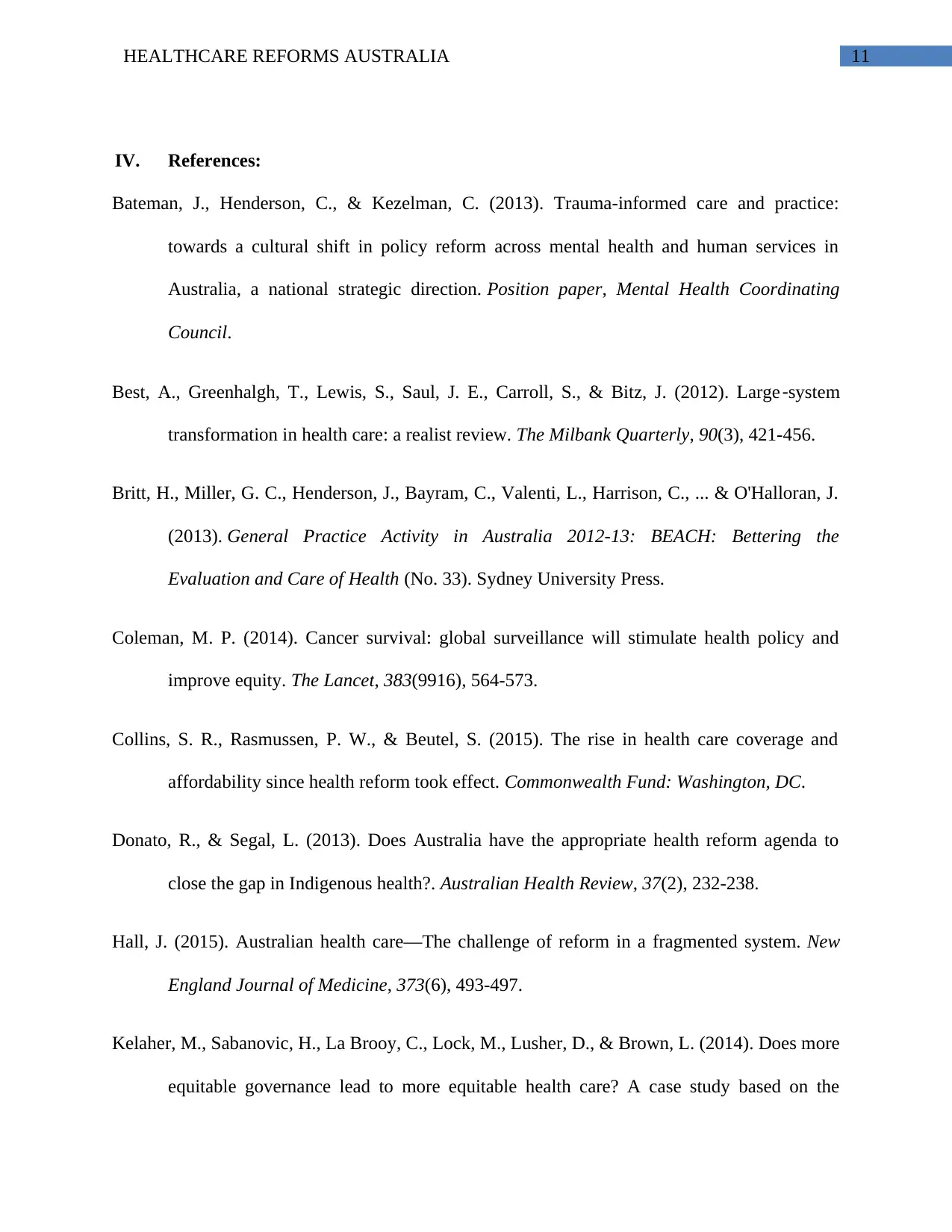
11HEALTHCARE REFORMS AUSTRALIA
IV. References:
Bateman, J., Henderson, C., & Kezelman, C. (2013). Trauma-informed care and practice:
towards a cultural shift in policy reform across mental health and human services in
Australia, a national strategic direction. Position paper, Mental Health Coordinating
Council.
Best, A., Greenhalgh, T., Lewis, S., Saul, J. E., Carroll, S., & Bitz, J. (2012). Large‐system
transformation in health care: a realist review. The Milbank Quarterly, 90(3), 421-456.
Britt, H., Miller, G. C., Henderson, J., Bayram, C., Valenti, L., Harrison, C., ... & O'Halloran, J.
(2013). General Practice Activity in Australia 2012-13: BEACH: Bettering the
Evaluation and Care of Health (No. 33). Sydney University Press.
Coleman, M. P. (2014). Cancer survival: global surveillance will stimulate health policy and
improve equity. The Lancet, 383(9916), 564-573.
Collins, S. R., Rasmussen, P. W., & Beutel, S. (2015). The rise in health care coverage and
affordability since health reform took effect. Commonwealth Fund: Washington, DC.
Donato, R., & Segal, L. (2013). Does Australia have the appropriate health reform agenda to
close the gap in Indigenous health?. Australian Health Review, 37(2), 232-238.
Hall, J. (2015). Australian health care—The challenge of reform in a fragmented system. New
England Journal of Medicine, 373(6), 493-497.
Kelaher, M., Sabanovic, H., La Brooy, C., Lock, M., Lusher, D., & Brown, L. (2014). Does more
equitable governance lead to more equitable health care? A case study based on the
IV. References:
Bateman, J., Henderson, C., & Kezelman, C. (2013). Trauma-informed care and practice:
towards a cultural shift in policy reform across mental health and human services in
Australia, a national strategic direction. Position paper, Mental Health Coordinating
Council.
Best, A., Greenhalgh, T., Lewis, S., Saul, J. E., Carroll, S., & Bitz, J. (2012). Large‐system
transformation in health care: a realist review. The Milbank Quarterly, 90(3), 421-456.
Britt, H., Miller, G. C., Henderson, J., Bayram, C., Valenti, L., Harrison, C., ... & O'Halloran, J.
(2013). General Practice Activity in Australia 2012-13: BEACH: Bettering the
Evaluation and Care of Health (No. 33). Sydney University Press.
Coleman, M. P. (2014). Cancer survival: global surveillance will stimulate health policy and
improve equity. The Lancet, 383(9916), 564-573.
Collins, S. R., Rasmussen, P. W., & Beutel, S. (2015). The rise in health care coverage and
affordability since health reform took effect. Commonwealth Fund: Washington, DC.
Donato, R., & Segal, L. (2013). Does Australia have the appropriate health reform agenda to
close the gap in Indigenous health?. Australian Health Review, 37(2), 232-238.
Hall, J. (2015). Australian health care—The challenge of reform in a fragmented system. New
England Journal of Medicine, 373(6), 493-497.
Kelaher, M., Sabanovic, H., La Brooy, C., Lock, M., Lusher, D., & Brown, L. (2014). Does more
equitable governance lead to more equitable health care? A case study based on the
⊘ This is a preview!⊘
Do you want full access?
Subscribe today to unlock all pages.

Trusted by 1+ million students worldwide
1 out of 14
Related Documents
Your All-in-One AI-Powered Toolkit for Academic Success.
+13062052269
info@desklib.com
Available 24*7 on WhatsApp / Email
![[object Object]](/_next/static/media/star-bottom.7253800d.svg)
Unlock your academic potential
Copyright © 2020–2025 A2Z Services. All Rights Reserved. Developed and managed by ZUCOL.




